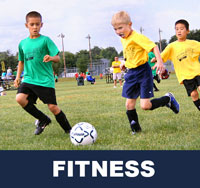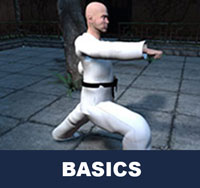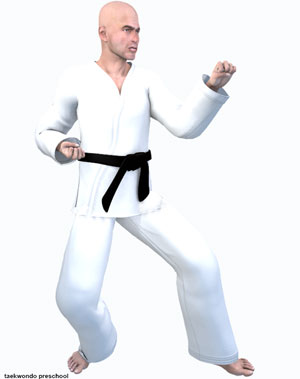Taekwondo 태권도Taekwondo Preschool
Promotion from one geup to the next can proceed rapidly in some schools, since schools often allow geup promotions every two, three, or four months. Students of geup rank learn the most basic techniques first, and then move on to more advanced techniques as they approach first dan. Many of the older and more traditional schools often take longer to allow students to test for higher ranks than newer, more contemporary schools, as they may not have the required testing intervals. View Taekwondo belt levels »

About Agility
Sports injuries are injuries that occur in athletic activities. They can result from acute trauma, or from overuse of a particular body part. Please see a certified specialist or doctor for sports injuries. Proper guidance and instructions are needed from a certified Master Instructor ( 사범님 sabeomnim ) to ensure safe training.
Agility or nimbleness is the ability to change the body's position efficiently, and requires the integration of isolated movement skills using a combination of balance, coordination, speed, reflexes, strength, and endurance. Agility is the ability to change the direction of the body in an efficient and effective manner and to achieve this requires a combination of;
- balance – the ability to maintain equilibrium when stationary or moving (i.e. not to fall over) through the coordinated actions of our sensory functions (eyes, ears and the proprioceptive organs in our joints);
- static balance – the ability to retain the centre of mass above the base of support in a stationary position;
- dynamic balance – the ability to maintain balance with body movement; speed - the ability to move all or part of the body quickly; strength - the ability of a muscle or muscle group to overcome a resistance; and lastly,
- co-ordination – the ability to control the movement of the body in co-operation with the body's sensory functions (e.g., in catching a ball [ball, hand and eye co-ordination]).

Agility Drills
Agility drills are used in the aim of improving sports agility, the ability to change direction while in motion. The ability to change direction while in motion is very important in many sports but especially in team and dual sports. For example, a football running back must be able to quickly change direction when he sees an opponent preparing to tackle him. A soccer player must be able to quickly change directions when dribbling the ball or when trying to get the ball away from an opponent. A tennis player must be able to quickly change directions when moving to a position where the ball is expected to go but instead finds the ball going in a different direction.
The quicker and sharper the changes in direction, the better the athlete can elude or stay with his or her opponent. The ability to make quick sharp changes in direction also enables the player to exhibit great quickness. In sports such as football there are many good running backs and receivers who can run fast in a straight line. But in order for them to be great, they must also be able to elude their opponents by changing direction quickly. If they do not have this ability they will never be great.
Thus the ability to change direction quickly while in motion is critical for sports success. Because of this coaches have devised many drills to improve this ability. In general, these drills are specific to different sports but some of them are applicable to many sports. For example, tumbling drills are usually more specific to swimmers who execute a flip turn and to gymnasts who use some aspects of tumbling in their routines on the apparatus or in free exercise.
Ladders, hurdles, and cones
The drills that use ladders, hurdles and cones have proven to be extremely popular and are now used extensively in many different sports. By using these drills coaches take it for granted that the athletes will become quicker and faster and many cases, more explosive. However, close examination of these popular drills and how they are executed, shows that the actions involved in executing these drills is not specific to the actions that the athlete must execute in gameplay.
Cutting Action
Agility drills can be of benefit to athletes if the drills duplicate or use the cutting action. In this way the athlete gets reinforcement of the action and will be able to get a little quicker or faster as his sports skill is fine tuned. Being able to duplicate the key action that is involved in execution of the sports agility skill is the secret to the success of any agility drill. When the drills are executed often enough there is a transfer of how the athlete executes the skill to gameplay.

Thus if athletes do many ladder, hurdle or cone drills, they learn to drive the knees upward rather than forward. If instead they duplicated a true cutting action in which the feet stay close to the ground and the knees are driven forward it could bring about a positive transfer that could improve skill execution. Practicing the cutting action in a drill would be much more productive.
It is also possible to have coaches talk of developing fast feet with agility drills. Most often they use ladder drills in which you step over each rung and then stutter step two or three times before stepping over the next ladder step. You continue in this manner for the full length of the ladder. For variety they also have the athlete traverse the entire ladder sideways. Execution is basically the same in which the athletes drive the knees upward to go over each rung of the ladder. Also sometimes included are stutter steps in between which are supposed to develop faster feet.
However, the cutting action, which is the basis for running agility, is not a matter of fast feet, it is a matter of fast legs. One must be able to move the legs from the hips in order to move quickly or to execute quick cutting actions. In addition, the feet must remain close to the ground regardless of whether the step being taking is short or long. In other words, as the cut is being executed, the body is lowered and as the athlete pushes off, he steps out with the leg closest to the direction in which he wishes to move. He then takes a step out with the leg and turns the body so he can quickly assume the running position. At times, it is necessary that the athlete have the ability to rotate the hips and/or shoulders a full 90° in order to be more evasive in the cutting action. This allows him to maintain eye contact with his opponent and maintain his shoulders in a front-facing position. In so doing, the opponent does not get any hints that a change in direction is about to take place. Hurdle drills are essentially the same as ladder drills since their execution is basically the same. In these drills, you move in a linear or sideward manner. Cone drills however, are used mainly for side movements. In the drills, you leap sideways over a cone in one direction and then back in the opposite direction. The key to successful execution is a high knee drive to successfully clear the top of the cone. They do not duplicate the cutting action.
For the drill to be successful in relation to improving sports performance on the field or court, it must include cutting actions. Learning how to do the cutting action is imperative. It involves both technical and physical components that are learned skills. These skills must be mastered in order to get maximum benefit in the agility drill.

Related Articles
Physical fitness is a general state of health and well-being or specifically the ability to perform aspects of sports or occupations. It is a set of attributes or characteristics that people have or achieve that relates to the ability to perform physical activity. View Physical Fitness »
- Stretch - Form of physical exercise in which a specific muscle or tendon (or muscle group) is deliberately flexed or stretched in order to improve the muscle's felt elasticity and achieve comfortable muscle tone. The result is a feeling of increased muscle control, flexibility and range of motion.
- Flexibility - Refers to the absolute range of movement in a joint or series of joints, and length in muscles that cross the joints. Flexibility in some joints can be increased to a certain degree by exercise, with stretching a common exercise component to maintain or improve flexibility.
- Endurance - Ability of a practitioner to exert itself and remain active for a long period of time, as well as its ability to resist, withstand, recover from, and have immunity to trauma, wounds, or fatigue.
- Balance - Ability to maintain the line of gravity (vertical line from centre of mass) of a body within the base of support with minimal postural sway. Sway is the horizontal movement of the centre of gravity even when a person is standing still.
- Agility - Or nimbleness is the ability to change the body's position efficiently, and requires the integration of isolated movement skills using a combination of balance, coordination, speed, reflexes, strength, and endurance.

Taekwondo Basics
Here is where you can learn more about Taekwondo 태권도. Knowing the fundamental basics is very important for your learning path as you build your skills and knowledge. There are certain rules that need to be followed to show respect to the master ( 사범님 sabeomnim ), the instructors ( 교사님 gyosannim ), other practitioners and to the martial arts. They vary between schools but many have similar rules and guidelines. For more information View Taekwondo Basics »
Please follow the guidance of a certified Master Instructor or trainer when doing sports related activities. The article provided on this page is information that is widely available on Wikipedia articles "Agility" and "Agility Drills". Risk of injury can be reduced by completing an effective warm up consisting of a heart raiser to get your pulse up, followed by sport specific dynamic stretches (stretches whilst moving).
There are five tenets defined in the International Taekwondo Federation (ITF) and several more in World Taekwondo (WT).
Perseverance ( 인내 in-nae ): "One will persevere time and time again until they have achieved a result which is adequate towards what one was trying to achieve." View Taekwondo Tenets »
RESOURCES
This article uses material from the Wikipedia articles "Agility" and "Agility Drills", which is released under the Creative Commons Attribution-Share-Alike License 3.0.


















